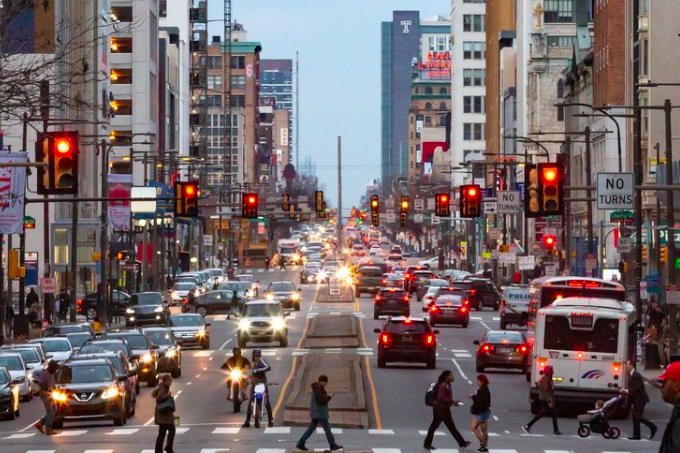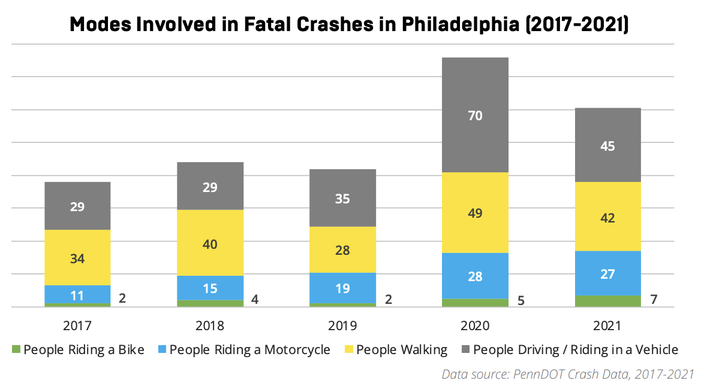
October 06, 2022
 Thom Carroll/for PhillyVoice
Thom Carroll/for PhillyVoice
Traffic fatalities fell in Philadelphia last year, but the number of crashes and incidents resulting in serious injuries increased, the city's latest Vision Zero report shows. The city's budget for Vision Zero will increase in 2023 to $23, the highest it has been since 2018.
The latest progress report on Philadelphia's Vision Zero commitment to improve road safety and eliminate traffic deaths shows mixed results.
Traffic fatalities fell to 121 last year, down from a 10-year high of 152 in 2020. That was the deadliest year for Philadelphia since there were 169 road fatalities in 1990.
But despite fewer deaths in 2021, crashes involving serious injuries rose from 401 in 2020 to 438 last year. The total number of crashes also increased, climbing from 7,799 to 8,120. Yet, the total number of crashes is still significantly lower than it was five years ago.
| Year | Crashes | Traffic Deaths | Serious Injuries |
| 2017 | 9,192 | 76 | 245 |
| 2018 | 8,764 | 88 | 233 |
| 2019 | 8,891 | 84 | 402 |
| 2020 | 7,799 | 152 | 401 |
| 2021 | 8,120 | 121 | 438 |
"After a tragic spike in traffic deaths in 2020, we had hoped for a dramatic decrease in 2021. This was not the case," said Mike Carroll, the city's deputy managing director for transportation.
In 2017, Mayor Jim Kenney released a Vision Zero plan aimed at eliminating traffic fatalities by 2030. The city has focused on roadway improvements, expanded bike infrastructure and efforts to reduce speeding on dangerous corridors.
Philly's rate of traffic fatalities – 7 deaths per 100,000 residents – is the fourth highest among major U.S. cities. The city is well above New York (2.59), Boston (3.05), San Francisco (3.61) and Chicago (5.04), and just below Los Angeles (7.38).
This year, Philadelphia recorded 96 traffic fatalities through September, including 43 pedestrians, 12 motorcycle riders, three bicyclists and one ATV rider, in addition to the people killed in crashes only involving cars, according to data tracked by the Bicycle Coalition of Greater Philadelphia.
The report shows that pedestrians, motorcyclists and bicyclists are far more likely to die when they are involved in traffic crashes.
Pedestrians were involved in 15% of crashes over the last five years, but accounted for 38% of traffic deaths. That nearly equaled the percentage of traffic deaths that involved people in cars.
The graphic above breaks down the traffic fatalities in Philadelphia from 2017 to 2021.
People riding motorcycles accounted for 19% of traffic deaths; bicyclists represented 4%. They each were involved in just 3% of total crashes.
Aggressive driving was deemed a contributing factor in 43% of fatal and serious injury crashes last year. Speeding was the most common factor, followed by running red lights and distracted driving.
Over the last year, the city has funded repaving and improving roadways on Philadelphia's High Injury Network, a collection of the most dangerous streets in the city. These include projects along Chestnut Street and Cobbs Creek Parkway in West Philadelphia, Washington Avenue in South Philadelphia, and Lehigh Avenue in Kensington and Port Richmond.
In addition to roadway improvements meant to discourage speeding, the city aims to reduce speed limits to 25 mph on all city streets in 2023.
Philadelphia also has continued to add protected bike lanes. There are now about 20 miles of protected bike lanes, up from 13.5 miles last September. The city anticipates reaching a goal of 40 miles in 2024.
This year, Philadelphia resumed accepting community applications for neighborhood slow zones. These zones work with residents to design and implement traffic safety improvements like speed cushions, lower speed limits and corner clearances that free up crosswalks from parked cars. The city's first two neighborhood slow zones, initiated in Kensington in 2019, were completed earlier this year.
The report also points to encouraging results from the automated speed enforcement program on Roosevelt Boulevard, which began in 2020. Since that time, speeding violations on Roosevelt Boulevard are down 92%. There have been 44% fewer crashes and 49% fewer traffic deaths during the first year and a half of the program.
Philadelphia's Vision Zero budget — including funds from the city, state and federal government — will increase by $6 million to $23 million in 2023, the highest it has been since 2018.
 Source/City of Philadelphia
Source/City of Philadelphia